NASA wants $1 billion to build a space tug that will maneuver the ISS when it comes time to shut it down
A NASA is conducting decommissioning plans for International Space Station (ISS), which is expected to make a controlled re-entry into Earth’s atmosphere and dive into the South Pacific Ocean in January 2031. The main question is how best to do this.
The space agency has options, but since redundancy is never too much, the 2024 budget proposal requests $1 billion for the construction of a space tugintended to aid in the descent maneuvers of the ISS, facilitating its final dive.
In February 2022, NASA officially revealed plans to shut down ISS operations. In use since 1998, it was the result of a coordinated effort of several nations (not you, Brazil), but everything has a limit. In the absence of a replacement, as plans for Gateway Station are more than rolled up, NASA already has a scenario in which it will have to limit the use of the current station, without having another one.
The plan is to gradually reduce the orbit of the ISS over the next few years, while the space agency carries out smaller-scale projects and experiments, and shuts down and moves what can be used to the ground. The station is expected to reach its tipping point between September 2030 and January 2031, at which point it will be caught in Earth’s gravity and begin falling towards the planet.
To control descent, NASA originally planned to use both the main engines and docked modules to control speed and direct the facility for a plunge into the Pacific, but the Russian invasion of Ukraine complicated matters.
The ROS, or Russian Orbital Segment, is the module responsible for the station’s propulsion, altitude control and maneuvering systems, and Roscosmos, managed by Dmitry Rogozin, threatened to separate him when the war started, reinforcing the prediction that the country will withdraw from the ISS consortium in 2024. His successor, former Deputy Prime Minister Yury Borisov, strengthened the threat.
The truth is that the ISS was designed to function in such a way that the modules depend on each other; although the ROS generates propulsion, it does not have its own energy systems, these are present in the main module, managed by the United States, and therefore the chances of a decoupling are very low.
However, the plan to “bring down” the ISS also relied on Russian Progress capsules to generate the necessary displacement. These are not likely to be made available by Moscow given the current tensions. That said, NASA has floated the possibility of an alternative plan, using an old and discarded design: a space tug.

Originally, the tug was part of the Space Transportation System, a NASA project to develop a variety of reusable vehicles, a different approach to the Apollo program and its single-use rockets/modules. In the plans, the agency proposed three distinct orbital stations, one in low orbit, another geostationary and the last one on the Moon.
Also in this program was a geostationary ferry, powered by nuclear energy via NERVA engines, which would serve as a transit station between Earth and Moon orbits, or to other points in the Solar System (probably Mars and/or Venus), from spacecraft to crew and cargo. For the transit between the two Earth orbits the tug would be more than sufficient, even if it could be adapted to fly to the Moon.
In practice, the only vehicle proposed by NASA that became a reality when its budget was approved by the US Congress was the space shuttle.
Russia has also proposed a project for an inter-orbit transfer vehicle, the Parom, but the MEV-1 mission was the first successful of its kind, when it mated with the Intelsat 901 satellite in 2020, retrofitting it to one orbit safe. In 2021, MEV-2 did the same with Intelsat 10-02, the first to get a “little boost” while still in operation, which extended its useful life.
<span data-mce-type=”bookmark” style=”display: inline-block; width: 0px; overflow: hidden; line-height: 0;” class=”mce_SELRES_start”>
Now, NASA wants to apply the same principle to the ISS. The tug would have the task of providing adequate additional propulsion to the ROS, in order to ensure the controlled reduction of the orbit and the eventual fall towards the ocean, so as not to harm anyone.
Budget data indicate that initial development work on the space tug cost US$180 million; the final amount is open, as it will depend on the proposals that the agency will receive from companies interested in the initiative, but the estimate is that the final amount will be around 1 billion dollars.
That may sound like a lot, but it’s a small price for not letting the ISS get out of control, like certain agencies do with their releases.
Source: Space news
NASA wants a $1 billion tug to dismantle the ISS
Source: Terra
Rose James is a Gossipify movie and series reviewer known for her in-depth analysis and unique perspective on the latest releases. With a background in film studies, she provides engaging and informative reviews, and keeps readers up to date with industry trends and emerging talents.






